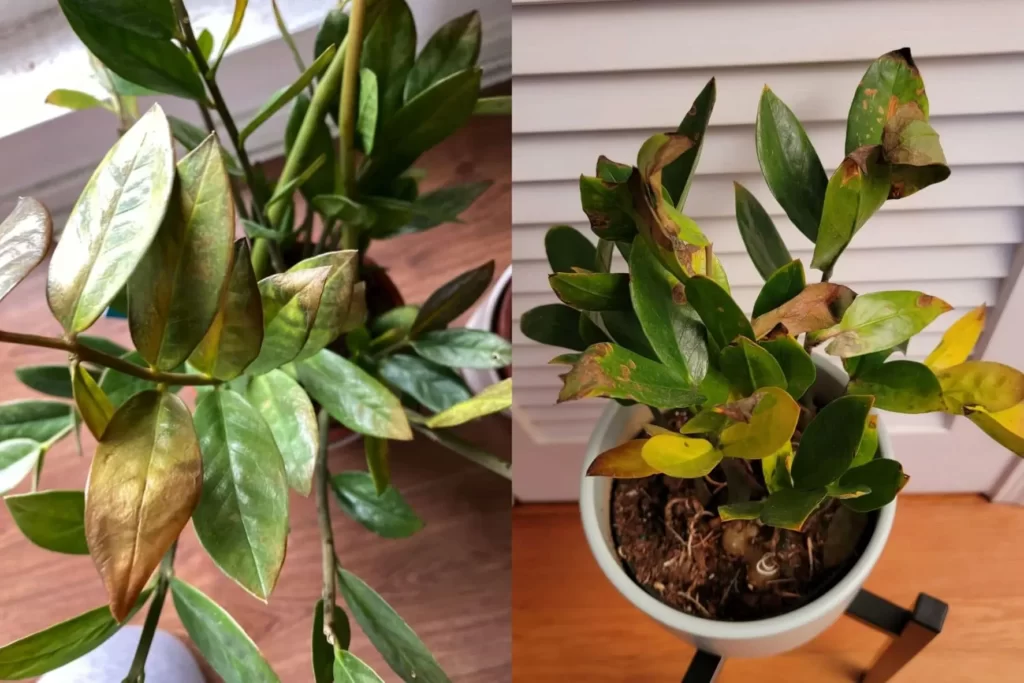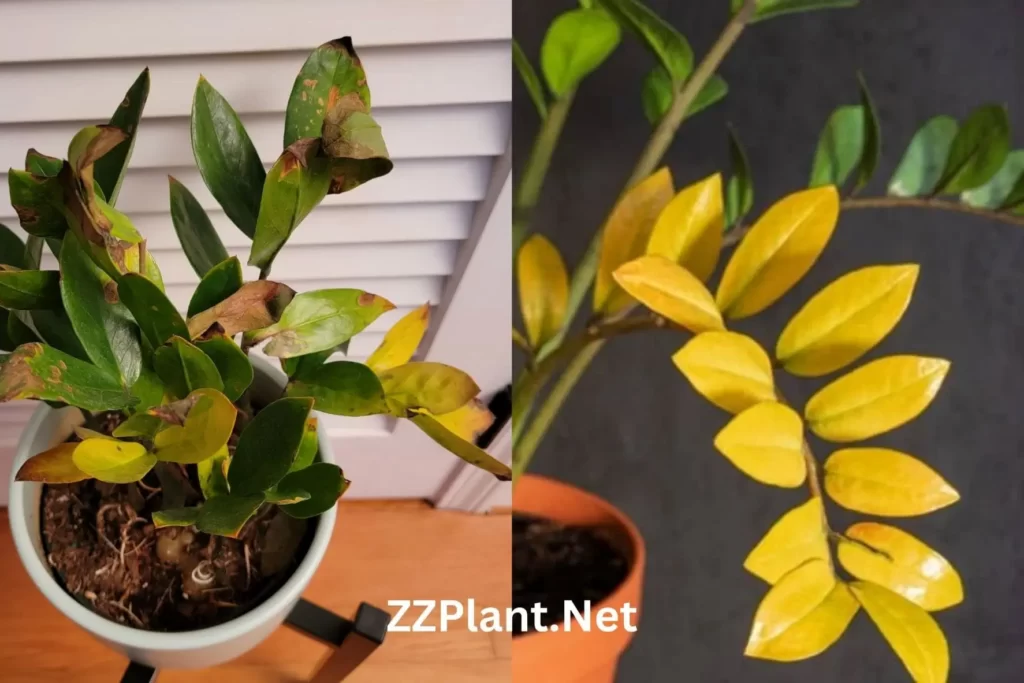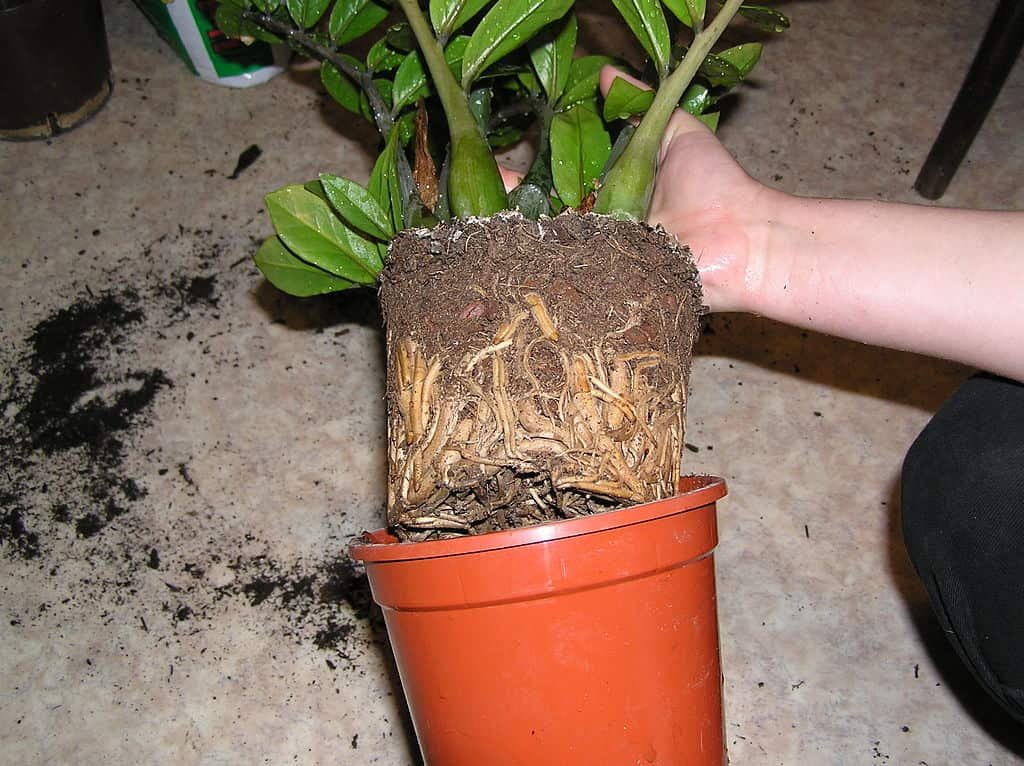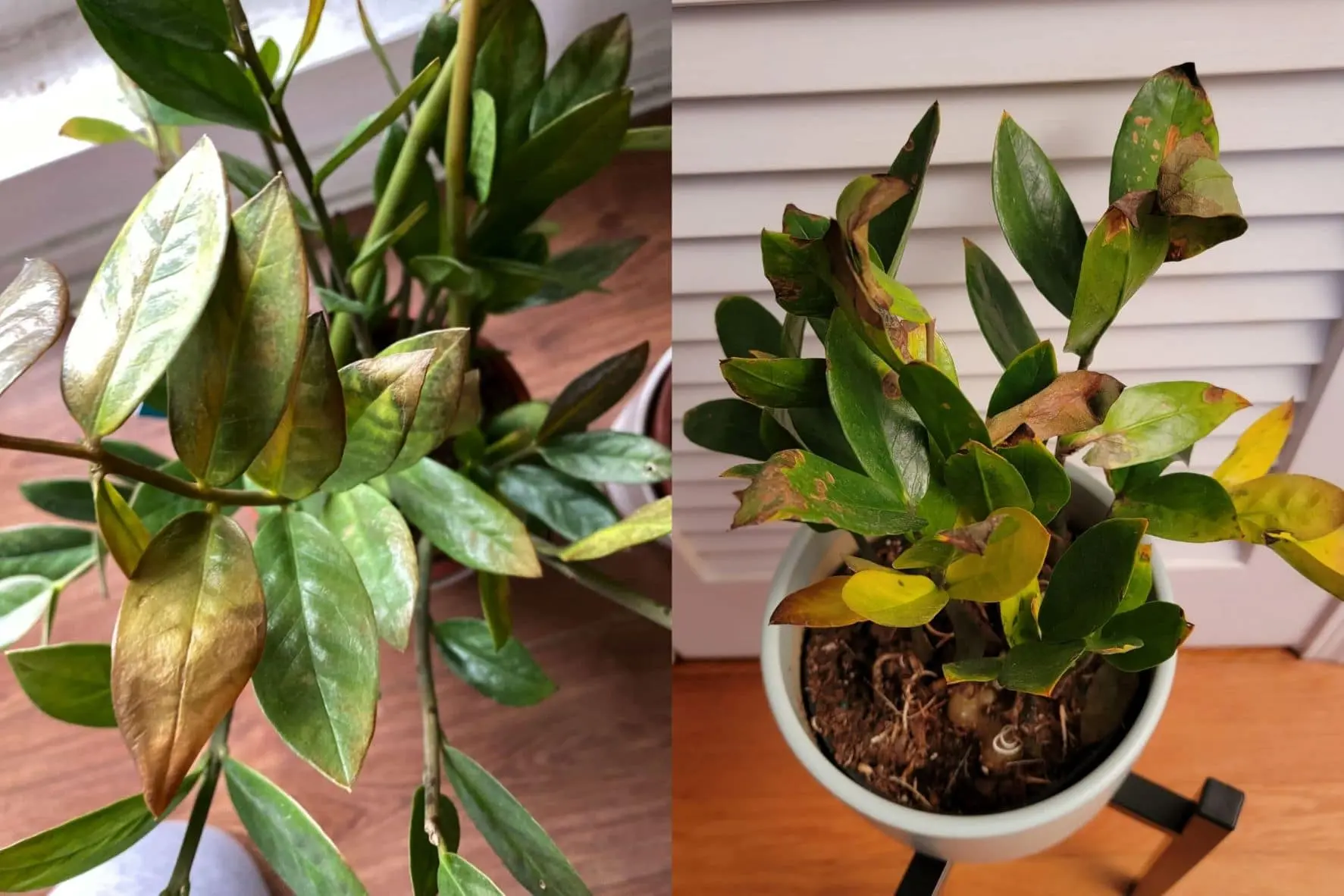ZZ Plants, also known as Zamioculcas Zamiifolia, are popular indoor plants known for their hardy nature and easy care requirements.
However, even these resilient plants can suffer from underwatering.
In this blog post, we will discuss the signs of an underwatered ZZ Plant, solutions for correcting the problem, and frequently asked questions about caring for these beautiful plants.
5 Reasons a ZZ Plant Becomes Dehydrated
There are several reasons why a ZZ Plant may become dehydrated:
1. Not enough water:
ZZ plants are drought-tolerant plants, but they still need to be watered regularly. If you water your ZZ plant too infrequently, the leaves will start to droop and the plant may eventually die.
This is because the plant’s roots will not be able to absorb enough water to keep the plant hydrated.
The amount of water that a ZZ plant needs will depend on a number of factors, including the size of the plant, the type of soil it is planted in, and the climate in your home.
However, as a general rule, you should water your ZZ plant every 2-3 weeks. You can check to see if your plant needs water by sticking your finger a few inches into the soil.
If the soil is dry to the touch, it is time to water the plant.
2. High temperatures:
ZZ plants are native to tropical climates, so they are used to warm temperatures. However, if the temperature in your home gets too high, the plant will lose water more quickly. This can lead to dehydration.
The ideal temperature range for ZZ plants is between 60 and 75 degrees Fahrenheit. If the temperature in your home gets above 85 degrees Fahrenheit, the plant may start to show signs of dehydration.
3. Low humidity:
As we mentioned before, ZZ plants are native to tropical climates, which have high humidity levels. If the humidity in your home is low, the plant will lose water more quickly. This can lead to dehydration.
The ideal humidity range for ZZ plants is between 40 and 50%. If the humidity in your home is below 40%, the plant may start to show signs of dehydration.
4. Poor drainage:
ZZ plants are drought-tolerant plants, but they still need good drainage. If your ZZ plant is in a pot with poor drainage, the water will not be able to drain out of the soil, and the roots will eventually rot.
This will prevent the plant from absorbing water, and it will become dehydrated.
Here are some reasons why poor drainage can lead to ZZ plant dehydration:
- Root rot. When the roots of a plant rot, they are unable to absorb water. This can lead to dehydration, even if the plant is watered regularly.
- Soil compaction. Over time, the soil in a pot can become compacted. This can prevent water from draining properly, and can also damage the roots of the plant.
- Pot size. If a plant is in a pot that is too small, the roots will not have enough room to grow. This can also lead to poor drainage, and can eventually cause the roots to rot.
If you think your ZZ plant is dehydrated due to poor drainage, there are a few things you can do to help it recover:
- Repot the plant in a pot with better drainage. When you repot the plant, choose a pot that is one size larger than the current pot. This will give the roots more room to grow, and will also help to improve drainage.
- Use a potting mix that is well-draining. There are many different potting mixes available that are designed for plants that need good drainage. Choose a potting mix that is specifically designed for ZZ plants, or for succulents and cacti.
- Water the plant less often. If you are used to watering your ZZ plant frequently, you may need to water it less often once you have repotted it in a pot with better drainage.
5. Lack of nutrients:
We all know ZZ plants are relatively low-maintenance plants and can thrive in low-nutrient soil.
However, if a ZZ plant is not receiving enough nutrients, it may start to show signs of dehydration.
Here are some reasons why lack of nutrients can lead to ZZ plant dehydration:
- Nutrient deficiency. When a plant does not have enough nutrients, it may not be able to absorb water properly. This can lead to dehydration, even if the plant is watered regularly.
- Poor soil quality. If the soil that a plant is planted in is not nutrient-rich, the plant may not be able to get the nutrients it needs. This can also lead to dehydration.
- Overwatering. Overwatering can leach nutrients out of the soil, which can lead to nutrient deficiency.
If you think your ZZ plant is dehydrated due to lack of nutrients, there are a few things you can do to help it recover:
- Fertilize the plant. Use a fertilizer that is specifically designed for ZZ plants, or for succulents and cacti.
- Repot the plant in nutrient-rich soil. When you repot the plant, choose a potting mix that is specifically designed for ZZ plants, or for succulents and cacti.
- Water the plant less often. If you are used to watering your ZZ plant frequently, you may need to water it less often once you have repotted it in nutrient-rich soil.
With proper care, your ZZ plant should recover from dehydration and thrive.

Signs of an Underwatered ZZ Plant
Wilted leaves:
The first sign of an underwatered ZZ Plant is wilted leaves. If the leaves of your plant are drooping or curling, it is a clear sign that the plant is not getting enough water.
This is because the plant is not able to absorb enough water to support its growth and the leaves are drooping as a result.
Brown or yellow leaves:

Another sign of under watering is brown or yellow leaves. This is a sign that the plant is not getting enough water to support its growth and is starting to die back. The leaves may also appear dry and crispy.
Dry, crumbly soil:
If the soil in the pot feels dry and crumbly to the touch, it is likely that the plant is not getting enough water. The soil may also be pulling away from the sides of the pot, indicating that it is too dry.
Slow growth:
If the plant is not getting enough water, it will not be able to grow as quickly as it should. The leaves may also be smaller than usual and the plant may be shorter than it should be.
Root Rot:
As the plant is not getting enough water, the roots are not able to absorb enough water to support the growth of the plant, so they start rotting.
It’s important to pay attention to these signs and act quickly to correct the problem before the plant becomes too dehydrated. If the plant is severely dehydrated, it may be too far gone to save, but with proper care and attention, it can recover and thrive.
Solutions for an Underwatered ZZ Plant
Water the plant thoroughly:
The first step in correcting an underwatered ZZ Plant is to water it thoroughly. Make sure that the soil is saturated with water and that excess water is draining away from the pot. Water the plant until you see water coming out of the drainage holes.
Check soil moisture level:
Use a moisture meter to check the soil moisture level and ensure that the plant is getting enough water. The ideal soil moisture level for a ZZ Plant is between 50-60%.
Repot the plant in fresh, moist soil:

If the soil is dry and crumbly, it may be necessary to repot the plant in fresh, moist soil. This will help to ensure that the plant has access to the water and nutrients it needs to thrive.
Increase humidity around the plant:
Another solution for an underwatered ZZ Plant is to increase the humidity around the plant. This Plants prefer a humid environment, so if the air in your home is dry, it may be necessary to use a humidifier or place a tray of water near the plant to increase humidity.
Monitor the plant:
After watering and repotting the plant, monitor it closely for any signs of improvement. Observe if the leaves are becoming less wilted or if new growth is appearing.
Adjust watering schedule:

Based on the moisture level of the soil, adjust the watering schedule accordingly. If the soil is still too dry, water the plant more frequently. If the soil is too wet, wait a few days before watering again.
It’s important to remember that ZZ Plants are hardy and resilient, but they still need proper care and attention. By following these solutions and monitoring the plant closely, you can help your ZZ Plant recover from underwatering and thrive.
Best Watering Schedule For ZZ Plant
The best watering schedule for a ZZ Plant can vary depending on the specific conditions in your home, such as humidity, temperature, and light levels.
However, a general watering schedule for a ZZ Plant is as follows:
- Water the plant when the soil feels dry to the touch: A good rule of thumb is to water the plant when the top inch of the soil feels dry to the touch. You can use a moisture meter to check the soil moisture level and ensure that the plant is getting enough water.
- Allow the soil to dry out slightly between watering: It’s important to not overwater the plant, so allow the soil to dry out slightly between watering. This will help to prevent waterlogged soil, which can suffocate the roots and cause the plant to become dehydrated.
- Water deeply: When you do water the plant, make sure to water it deeply. This will help to ensure that the water reaches the roots and that the plant has enough water to support its growth.
- Water in the morning: Water the plant in the morning so the leaves have time to dry before the night.
- Use Room Temperature water: It’s best to use room temperature water when watering a ZZ Plant, as cold water can shock the roots and cause them to become damaged.
It’s important to monitor the plant and adjust the watering schedule as needed.
The watering schedule may need to be adjusted more frequently in the summer months when the plant is transpiring more water due to the higher temperatures. Also, make sure to fertilize the plant with appropriate fertilizers.
How Do I know If the Plant is Overwatered or Underwatered?
Determining whether a plant is overwatered or underwatered can be tricky, as the symptoms can be similar. However, there are a few key differences to look for:
- If the leaves are wilted and drooping, it is likely that the plant is underwatered. However, if the leaves are also yellow or brown and the soil is soggy, it may be overwatered.
- The soil moisture can be a good indicator of whether the plant is overwatered or underwatered. If the soil is dry and crumbly, the plant is likely underwatered. If the soil is soggy and waterlogged, the plant is likely overwatered.
- Overwatering can lead to root rot, which can cause the roots to turn brown and mushy. Root rot can also cause the leaves to turn yellow and fall off.
- Overwatering can also lead to the growth of fungus on the soil, which can be visible as white or gray mold.
- A musty smell can also be a sign of over-watering, as the soil is not draining properly and the roots are sitting in water.
It’s important to pay attention to your plant’s needs and monitor the environment to make sure it has enough water, proper humidity levels and good drainage.
Also, make sure to fertilize the plant with appropriate fertilizers. By doing this, you’ll be able to tell if your plant is overwatered or underwatered and take the necessary steps to fix the problem.
Related FAQs:
ZZ Plants prefer to be kept evenly moist, but not soggy. It is recommended to water your ZZ Plant once a week, but it’s always better to check the soil moisture level with a moisture meter.
Yes, it is possible to save an underwatered ZZ Plant if you catch the problem early and take steps to correct it. However, if the plant has been underwatered for an extended period of time, it may be too far gone to save.
No, it’s recommended to not fertilize your ZZ Plant while it’s recovering from underwatering. Wait until the plant has fully recovered and is showing new growth before fertilizing.
Conclusion
An underwatered ZZ Plant can be easily identified by its wilted leaves, brown or yellow leaves, and dry, crumbly soil.
The solutions to this problem are to water the plant thoroughly, repotting it in fresh, moist soil, and increase humidity around the plant.
With proper care and attention, your plant can recover and thrive. Remember to always check the soil moisture level with a moisture meter and not to fertilize your ZZ Plant while it’s recovering.
Happy planting!

